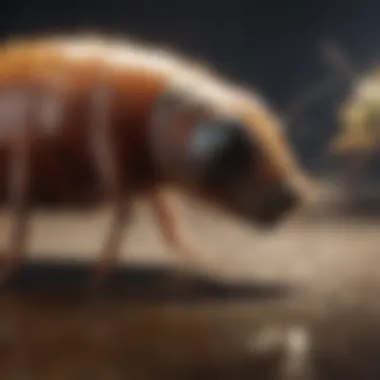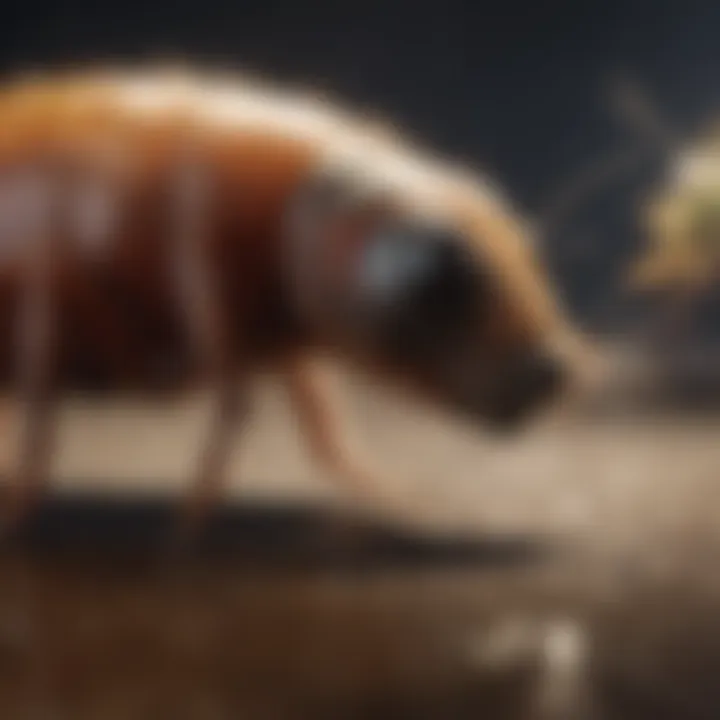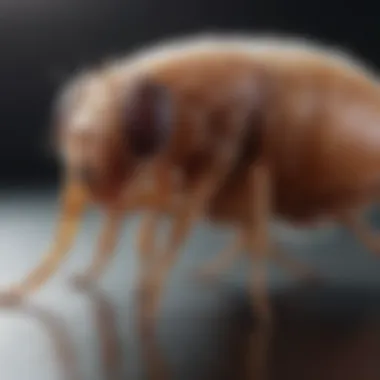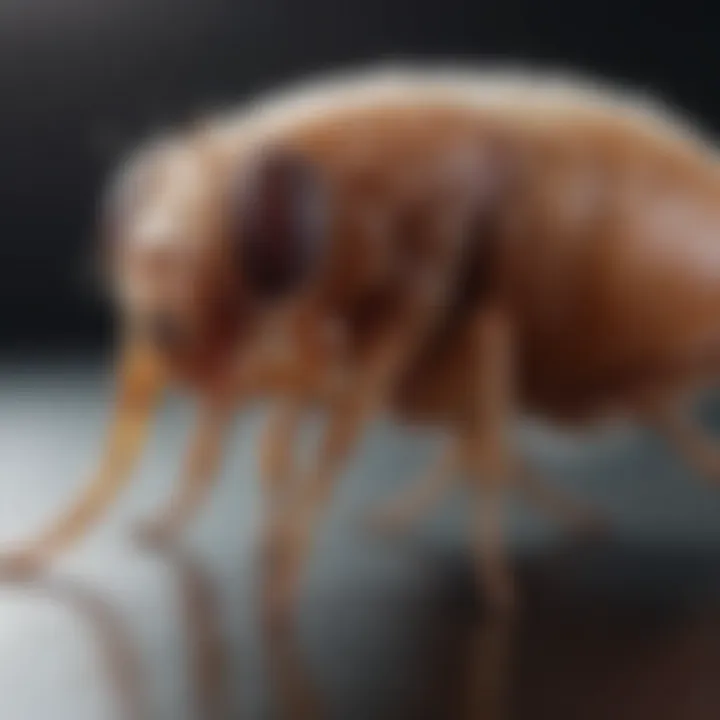Exploring Dog Fleas and Their Impact on Humans


Intro
The relationship between dog fleas and human hair is a topic that raises questions about the biology of these parasites. Understanding their life cycle and behavior is essential in assessing the actual risk they pose to humans. This article will delve into various aspects of dog fleas, including how they interact with humans and the potential health implications. Moreover, it will outline effective prevention and control strategies, aiming to clarify common misconceptions surrounding these pests.
Understanding the Pest
Identification
Dog fleas, scientifically known as Ctenocephalides canis, are small, wingless insects. Their bodies are flattened and can range in color from light brown to dark brown. Fleas are notorious for their jumping ability, which enables them to move quickly from one host to another. They typically measure about 1 to 2.5 millimeters in length.
Understanding their identification is crucial when trying to assess an infestation. Adult fleas can be found on pets, but their eggs and larvae may be present in the environment. Flea bites are characterized by small, red, itchy spots on the skin. In humans, these bites often occur on lower legs and ankles, signifying where fleas have encountered a potential host.
Life Cycle
The life cycle of dog fleas includes several stages: egg, larva, pupa, and adult. This cycle generally takes about three weeks to a month to complete, depending on environmental conditions.
- Egg: Female fleas can lay up to 50 eggs per day. These eggs are tiny and can easily fall off the host, contaminating the environment.
- Larva: The eggs hatch into larvae that feed on organic debris. Flea larvae are blind and avoid light, often found in dark places like carpets or bedding.
- Pupa: After several days, the larvae spin cocoons, entering pupa stage. This stage can last from days to months, allowing the flea to survive unfavorable conditions.
- Adult: Once a host is detected, the adult flea emerges from the cocoon, ready to feed on blood.
Understanding this life cycle assists in comprehending when and why fleas may invade human spaces, alerting household members to take preventive action.
Pest Prevention Strategies
Environment Modification
Preventing flea infestations starts with environmental management. This involves cleaning and modifying areas where pets spend time. Regular vacuuming of carpets, rugs, and furniture helps eliminate flea eggs and larvae.
Keep yard areas clean and trimmed, as these areas can harbor fleas. Washing pet bedding frequently with hot water is also beneficial. Consider using hypoallergenic detergents to ensure the safety of both pets and humans.
Physical Barriers
Physical barriers can also provide significant flea control. Flea collars for dogs can deter fleas from settling on pets. In addition, using tightly woven fabrics for furniture coverings can help reduce flea presence.
Employing door mats can minimize the transfer of fleas from the outside environment into the home. Clear communication with pets, ensuring consistent grooming habits, carries importance as well.
Control Methods
Chemical Control
When prevention fails, chemical control may be necessary. Various flea treatments exist, including topical spot-on treatments, oral medications, and flea shampoos. Frontline Plus and NexGard are popular options in the pet care industry. These chemicals work by targeting fleas at different life stages, effectively reducing infestations.
Remember to follow manufacturer instructions carefully to promote safety for pets and household members. Additionally, consult with a veterinarian for guidance on which product is the most suitable for a pet's specific needs.
Biological Control
Biological control methods involve the utilization of natural predators to manage flea populations. For example, nematodes are microscopic worms that can target flea larvae in the environment. Introducing beneficial insects into the yard can aid in maintaining low flea numbers.
Understanding dog fleas and how they interact with humans can lead to effective management strategies that enhance both pet and human health.
In summary, controlling fleas necessitates a multi-faceted approach, combining environmental modifications, physical barriers, and targeted control methods. By comprehending the behavior and biology of dog fleas, households can mitigate risks associated with these pests.
Preface
The issue of dog fleas interacting with humans, particularly with regard to human hair, is a topic of significant relevance in both pet husbandry and public health. Understanding this interaction can help mitigate risks that arise from flea infestations in the home environment. Dog fleas, particularly Ctenocephalides canis, are common parasites that thrive on dogs but can also pose threats to human health.


In this article, we will explore the biology, life cycle, and feeding habits of dog fleas. Knowledge of these elements is crucial. Understanding how fleas behave not only informs effective pest control measures but also aids in comprehending potential health implications for humans. Households with pets must consider factors that may lead to flea infestations, particularly the transmission dynamics between dogs and humans.
We will also investigate prevalent misconceptions about fleas, many of which stem from a lack of understanding of flea behavior and biology. Once myths are clarified, the article will discuss effective preventive measures and treatments for dealing with flea infestations, emphasizing how to maintain a healthy home environment for families and pets alike.
Therefore, this introduction lays the foundation for a comprehensive examination of the interaction between dog fleas and human hair. It is critical for homeowners, especially those with pets, to grasp these concepts. By delving into this subject, we hope to empower readers with the knowledge required to manage and prevent flea infestations effectively.
Understanding Dog Fleas
Understanding dog fleas is critical to grasping the broader interaction between these parasites and human beings. Fleas are not just annoyances to pets; they pose real risks to human health, especially when one might unknowingly come into contact with them. Gaining knowledge about dog fleas allows housewives and homeowners to take informed steps in managing both pets and household environments. Not only does this knowledge offer practical benefits in terms of prevention, but it also addresses common fears and misconceptions that can lead to unnecessary panic.
Biology of Dog Fleas
Dog fleas, chiefly Ctenocephalides canis, are small, wingless insects measuring about 1.5 to 3.3 millimeters in length. Their bodies are flattened laterally, allowing for easy navigation through fur and hair. The color of a flea can vary, mostly appearing brown or dark brown. This coloration helps them blend in, making them hard to spot.
A unique feature is their powerful legs, which enable them to jump over a distance many times their body length. These adaptations are crucial for their survival and reproduction. Fleas possess specialized mouthparts designed for piercing the skin of their hosts to feed on blood. Through their biology, fleas demonstrate exceptional resilience and adaptability to various environments.
Life Cycle of Dog Fleas
The life cycle of dog fleas consists of four stages: egg, larva, pupa, and adult. Understanding this cycle helps clarify how infestations can develop.
- Egg: Flea eggs are tiny, measuring around 0.5 mm, and are usually laid on the host animal.
- Larva: After hatching, the larvae emerge and live in the environment, feeding on organic debris and flea feces. They are roughly 2 to 5 mm long and have a distinct appearance.
- Pupa: Larvae spin cocoons, where they can remain dormant for extended periods until conditions are favorable for emergence.
- Adult: Once conditions are right, adults emerge from the pupal stage, seeking a host to feed and start the cycle over again. This entire process can take several weeks, but it can extend to months in less favorable environments.
Feeding Habits and Behavior
Dog fleas feed primarily on blood. Their feeding habits can lead to discomfort for pets, resulting in scratching and irritation. Fleas are most active in warm, humid conditions, which increase their chances of finding a host. They can sense body heat, carbon dioxide, and movement, which help them locate their next meal.
Fleas usually feed multiple times a day, obtaining enough nutrients to sustain reproduction. Specifically, female fleas require a significant amount of blood before laying eggs. This behavior creates additional challenges for pet owners, as flea infestations can escalate rapidly if not addressed early.
"Understanding the biology and life cycle of dog fleas is essential for effective management and prevention of infestations in homes with pets."
In summary, having a detailed understanding of dog fleas' biology, life cycle, and feeding behavior equips homeowners with the insights necessary to combat flea infestations effectively. By being aware of these aspects, individuals can foster a more harmonious living environment with their pets, minimizing the risks associated with dog fleas.
Can Dog Fleas Infest Human Hair?
The question of whether dog fleas can infest human hair is significant. It ties directly to understanding flea behavior and their biology. Dog fleas, scientifically known as Ctenocephalides canis, primarily target dogs but can occasionally find their way onto other hosts, including humans.
Understanding this interaction is crucial for several reasons. First, it underscores the importance of proper pet care and flea control methods to avoid infestations that may affect both dogs and humans. Second, recognizing the potential for fleas to interact with human environments helps in taking the right preventive measures. Finally, it dispels myths that can lead to unnecessary panic or neglect in flea management.
The anatomy of fleas plays a vital role in their ability to navigate and survive in various environments, including human hair. Their specialized body structures, such as strong legs for jumping, allow them to move efficiently between hosts. This adaptability raises concerns about their potential to infest human hair, especially when house owners have pets that are infested.
Flea Anatomy and Its Implications
Fleas possess a unique anatomy that facilitates their survival and ability to infest specific hosts. Their flattened bodies allow them to maneuver through thick fur or hair. Fleas have strong and well-developed legs, which enable them to jump over long distances relative to their body size. A flea can jump around 150 times its own length, making it capable of switching between hosts rapidly.
Here are some anatomical traits that are relevant:
- Mouthparts: Their piercing and sucking mouthparts are essential for feeding on blood. This ability is not limited to dogs; they can bite humans.
- Body Structure: The flat body allows for easy navigation within fur or hair, enhancing their chances of finding a suitable feeding site.
- Leg Strength: Their powerful legs provide agility, enabling them to leap onto a host quickly.
These anatomical features indicate that while dog fleas do not prefer humans as their primary host, they can certainly survive and feed on humans under certain conditions. Thus, understanding flea anatomy is significant in controlling and preventing infestations effectively.
Conditions for Infestation
The likelihood of dog fleas infesting human hair is contingent upon several conditions. Factors such as the environment, the presence of infested pets, and human behavior all contribute to the risk level.
- Environmental Factors: Fleas thrive in warm, humid conditions. Homes with carpets and bedding where infested pets roam can become breeding grounds. These conditions increase the risk of a flea jumping onto a human during close contact.
- Proximity to Infested Pets: Humans living with dogs that have an active flea infestation are at a greater risk. Close physical contact, such as petting or cuddling, can facilitate the transfer of fleas.
- Personal Hygiene: The grooming habits of individuals can influence flea attachment. Regular bathing and grooming can minimize the chances of fleas attaching to humans.
- Seasonal Changes: Fleas are more active during certain seasons. Warmer months often see increased flea activity as they reproduce more rapidly.


"An ounce of prevention is worth a pound of cure."
Preventive measures, such as regular pet treatments and household cleanliness, can significantly reduce the risk of fleas coming into contact with human hair. Understanding these conditions is vital for home owners to manage flea control effectively.
Human Reactions to Fleas
The interaction between humans and dog fleas can lead to several reactions that are important to understand. Since fleas feed on blood, their bites can provoke significant discomfort and health issues for humans. Understanding how these reactions occur is crucial for effective management and prevention. If left unchecked, these reactions can lead to more severe complications than just itching and irritation.
Skin Reactions to Flea Bites
Flea bites often result in immediate and observable skin reactions. When a flea bites, it injects saliva into the skin. This saliva contains allergens that can trigger an inflammatory response. Common symptoms include:
- Redness and swelling: The affected area may appear inflamed and swollen due to increased blood flow.
- Itching and discomfort: Many individuals experience intense itching which can lead to further irritation and potential skin damage.
- Rash or hives: Some might develop a rash or hives in response to the allergens in flea saliva.
The severity of these reactions varies among individuals. While some may exhibit only mild irritation, others can have more pronounced reactions. Regular exposure can lead to increased sensitivity over time, resulting in heightened responses to even a single flea bite.
Allergic Reactions and Dermatitis
In some cases, flea bites can lead to allergic reactions, specifically flea allergy dermatitis (FAD). This condition occurs when an individual's immune system overreacts to flea saliva. Symptoms of FAD are similar to typical skin reactions but may be much more severe and persistent. Key traits include:
- Chronic itching: Unlike normal itching which can subside, this can become chronic and distressing, often leading to excessive scratching.
- Skin infections: Prolonged scratching can cause breaks in the skin, inviting secondary bacterial infections.
- Inflammation: Severe cases can result in widespread inflammation and changes in skin texture.
Research indicates that even a small number of flea bites can trigger these reactions in sensitive individuals. Thus, preventive measures are essential to avoid exposure.
To manage conditions like FAD, individuals may need to seek medical advice. Treatments often involve topical corticosteroids and antihistamines to alleviate symptoms and reduce inflammation. Avoiding flea exposure is critical for those susceptible to allergic reactions.
Transmission Dynamics
Understanding the dynamics of how dog fleas transmit from dogs to humans is crucial in addressing this pervasive issue. Recognizing the interactions between these parasites and their potential to affect humans can guide effective prevention and treatment measures. This section will discuss how flea infestations spread, the impact of environmental factors, and the implications for pets and their owners.
From Dogs to Humans
Dog fleas primarily prefer canine hosts. However, they can occasionally transfer to humans. This usually occurs when a person comes into contact with infested pets or their environment. Fleas may jump from a dog’s coat onto a human’s clothing or skin during close contact. It's essential to note that while fleas can bite humans, they do not colonize human hair in the same way they do with a dog's fur.
When fleas end up on a human, they tend to feed and then attempt to return to a host they find more suitable, which is typically a dog or cat. The act of feeding can lead to discomfort and skin irritation for humans, and in some cases, it can cause allergic reactions. Regular grooming and the use of flea preventative treatments on pets can significantly reduce these transmission chances.
"Understanding the transmitter dynamics of dog fleas helps in preventing their spread effectively through household management and pet care."
Environmental Factors Involved
Environmental conditions play a critical role in the transmission of dog fleas. These parasites thrive in warm, humid climates, as such conditions favor their life cycle and increase their population density. Following are several environmental considerations that can influence flea transmission:
- Temperature: Fleas generally prefer temperatures between 70°F and 85°F. Extreme cold or heat can limit their survival.
- Humidity: A relative humidity of 50% to 90% is ideal for fleas, promoting their feeding and reproduction.
- Living Conditions: Cluttered and unclean living spaces provide more crevices for fleas to hide and thrive. Regular cleaning and vacuuming can help remove flea eggs, larvae, and adults.
- Other Pets: Multiple animals within a home can increase transmission opportunities. Infestations often spread rapidly in environments with various pets.
Effective prevention involves understanding these environmental factors and implementing strategies to control flea populations. Combining good hygiene practices with preventive treatments gives households the best chance at mitigating flea-related issues.
Myths and Misconceptions Surrounding Fleas
Understanding the various myths and misconceptions surrounding fleas is crucial for effectively managing and preventing flea infestations. Many beliefs about fleas are outdated or simply incorrect, which can lead to inadequate protection measures for households with pets, particularly dogs. This section aims to clarify these misunderstandings, providing insights that can help dog owners make informed decisions about flea control and management.
Common Misunderstandings
There are several prevalent myths regarding dog fleas. Here are a few:
- Fleas only infest dirty homes: Many people assume that fleas thrive only in unsanitary conditions. This is misleading. Fleas can infest clean homes just as easily as dirty ones. They are attracted to warmth and the presence of a host, making any environment conducive to their survival.
- Dog fleas prefer hair and fur: While fleas use hair and fur as a location to latch on, their primary purpose is to feed on blood, not to inhabit the hair itself. Fleas can quickly jump from a dog to a human, but they do not settle in human hair like lice do.
- Once treated, fleas are gone for good: This is a dangerous assumption. While treatments can kill adult fleas and larvae, it does not eliminate eggs. If not properly managed, new fleas can hatch, and the cycle will repeat. Continuous and comprehensive treatment is necessary.


These beliefs can lead to negligence toward prevention and treatment options, which can pose health risks to both pets and humans.
Scientific Clarifications
It is essential to base our understanding of fleas on scientific evidence rather than common beliefs. Here are some clarifications:
- Fleas are resilient: Fleas can survive in temperatures ranging from 45°F to 95°F. They can also withstand low humidity levels. Their ability to endure harsh environments reflects the importance of consistent management and treatment.
- Eggs and larvae: Fleas do not spend their entire lives on a host. Adult fleas lay eggs that fall off the host into the environment, primarily carpets and bedding. The larvae develop within these areas, feeding off organic matters like skin cells, pet waste, and environmental debris. This cycle can complicate eradication efforts, making it vital to treat the home as well as the pet.
- Human reactions differ: Fleas do bite humans, but individuals' reactions vary significantly. Some might exhibit no reaction, while others could experience severe allergic reactions. Therefore, the presence of fleas should be taken seriously regardless of personal experiences with bites.
Preventive Measures
Preventive measures are crucial in ensuring that homes remain free from the threat of dog fleas and potential infestations. Understanding the nature of dog fleas and their preferences can help in crafting an effective strategy. By implementing preventive tactics, homeowners can minimize the risk of fleas transferring from pets to humans. This proactive approach saves time and costs associated with treating infestations that make already existing conditions more complicated.
In this section, the discussion will center on two main areas: effective flea control for pets and home environment management, each playing a vital role in the overall prevention strategy.
Effective Flea Control for Pets
Controlling fleas on pets is the first line of defense against potential infestations. It is essential to choose appropriate treatments that effectively kill fleas at various life stages.
- Topical Treatments: Products such as Frontline or Advantage are often used directly on the skin of pets. These treatments can kill adult fleas quickly and provide protection for several weeks.
- Oral Medications: Medications like Comfortis or Capstar can be administered to kill fleas in a short time. They are especially useful for immediate relief from an existing infestation.
- Shampoos and Baths: Regular bathing of pets with flea shampoos can help maintain cleanliness and remove fleas. This should be done alongside topical or oral treatments for maximum efficacy.
- Regular Grooming: Brushing pets regularly can help catch any fleas before they can cause infestation. Groom brushes with fine teeth are particularly effective for identifying fleas.
Home Environment Management
Maintaining a flea-free environment is just as important as treating the pets themselves. Fleas can thrive in various areas of the home, making it necessary to adopt several tactics to minimize their presence.
- Vacuuming: Frequent vacuuming can help disturb flea eggs and larvae in carpets, upholstery, and pet bedding. It is essential to dispose of the vacuum bag or clean the canister outdoors to prevent recontamination.
- Washing Bedding: Regularly washing pet bedding and any blankets that pets use can eliminate fleas and eggs. Hot water is recommended to effectively kill these pests.
- Environmental Sprays: Chemical or natural flea sprays can be applied to the home environment. It is crucial to choose products that are pet-safe and effective in eliminating fleas.
- Outdoor Control: If pets spend time outdoors, manage the yard by cutting grass regularly and removing debris where fleas might breed.
"Proper management and preventive measures can significantly reduce the chances of dog fleas becoming a problem in homes."
In summary, being diligent in pet care and home cleanliness significantly lowers the risk of dog fleas infesting human hair. These steps not only protect pets but also enhance the quality of life for homeowners and their families.
Treatment for Flea Infestations
Flea infestations present a significant concern for pet owners and households. Understanding the appropriate treatments is vital to effectively manage and eradicate these pests. Treatment strategies range from topical applications to oral medications, each with distinct advantages and considerations. Since fleas pose health risks to both pets and humans, effective management is essential.
Topical Treatments and Shampoos
Topical treatments are one of the most common methods used to combat flea infestations. These products are applied directly to the skin of the pet and include a variety of formulations such as spot-on treatments, sprays, and shampoos. Each type has its own mode of action but generally targets fleas during their life cycle, reducing their population.
- Spot-On Treatments: These are highly concentrated, and usually involve applying the solution between the pet's shoulder blades. Products like Frontline and Advantage are popular among pet owners. They work by spreading across the skin through the natural oils. This provides long-lasting protection, typically for a month.
- Flea Shampoos: Shampoos can offer immediate relief from fleas, killing them on contact. However, they may not provide long-term protection. A bath using a comprehensive flea shampoo, such as Adams Flea & Tick Shampoo, can help eliminate adult fleas but often needs to be followed with preventive measures.
- Flea Sprays: These can be used both on pets and in the environment to kill adult fleas and prevent larvae from developing. Some pet owners may opt for sprays that contain insect growth regulators to break the flea life cycle effectively.
"Consistent application of topical treatments can minimize the likelihood of future infestations, allowing both pets and their owners to live more comfortably."
Oral Medications
Oral medications offer another effective avenue for flea treatment. These medications generally work systemically and infect the fleas when they feed on the host. Several benefits make oral medications appealing to pet owners.
- Convenience: Administering a pill or chewable can sometimes be simpler than applying topical solutions, especially for fidgety pets that resist being treated externally.
- Systemic Action: Brands like Comfortis and NexGard provide fast-acting solutions that kill fleas within hours of ingestion. This can be beneficial for quick relief from infestations.
- Long-lasting Effects: Many of these medications provide protection for a duration of 30 days or more, thus reducing the frequency of treatments needed.
While both topical treatments and oral medications serve to combat flea infestations effectively, it is crucial to consider the preferences of the pet and consultation with a veterinarian. Each pet might respond differently to specific treatments, requiring personalized approaches for optimal outcomes.
Closure
The implications of flea infestations extend beyond mere discomfort. Reactions to flea bites can lead to significant skin irritations and allergic responses in humans. Recognizing these symptoms allows for timely interventions. In addition, understanding how fleas transmit from dogs to humans provides a framework for prevention.
Common misconceptions surrounding fleas can lead to ineffective control strategies. It's essential to debunk these myths to inform proper pest management tactics. Simple yet effective preventive measures can safeguard both pets and humans. By implementing these strategies, families can considerably reduce the risks of infestations and related health hazards.
Ultimately, knowledge is empowering. The more one understands the behavior and life cycle of dog fleas, the better equipped they are to manage infestations. This understanding fosters a proactive approach to safeguarding home environments, contributing to the overall well-being of both pets and residents.
"Knowledge about dog fleas not only aids in management but also enhances the quality of life for both pets and their owners."
Through these insights, households can foster a healthier living environment, minimizing stress and discomfort associated with pet ownership. This article serves as a comprehensive guide for anyone looking to deepen their understanding of fleas and their impact on human health.







